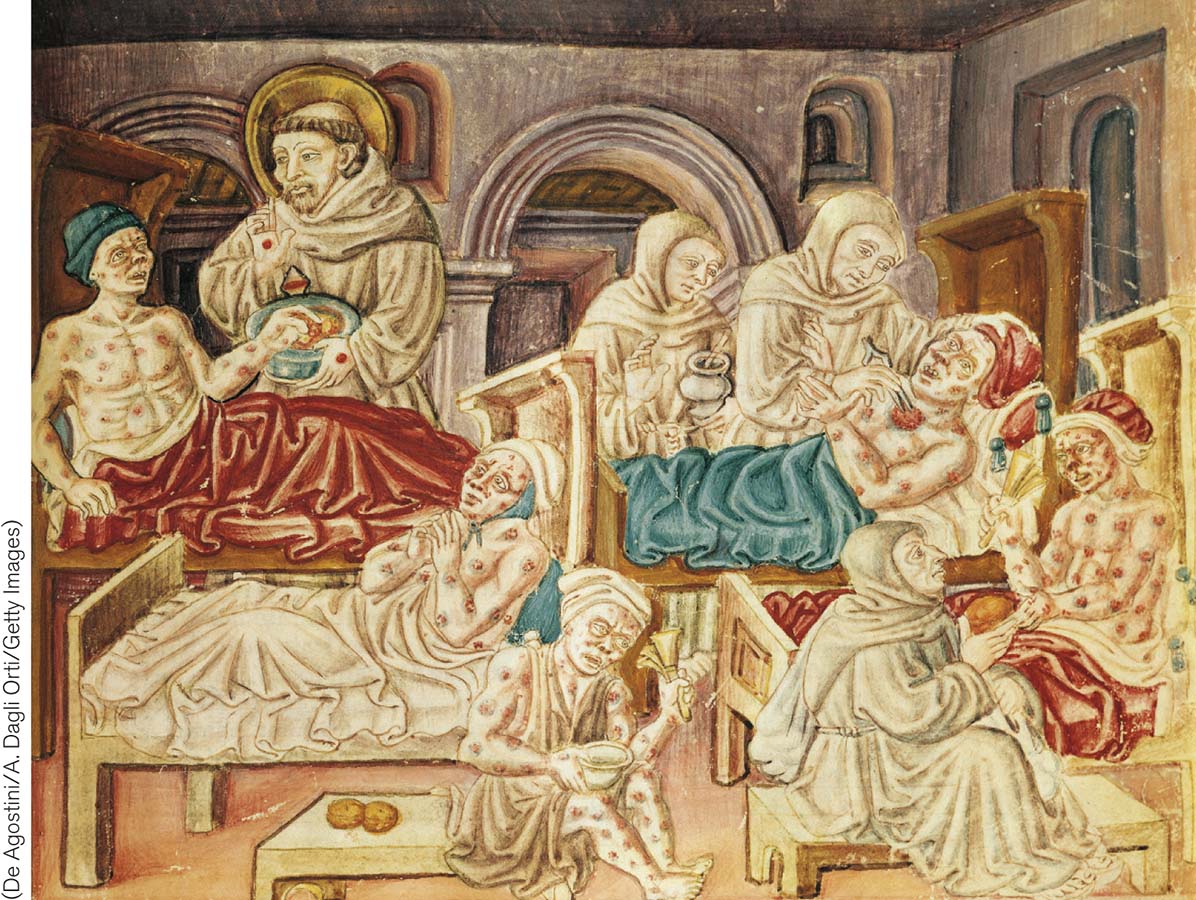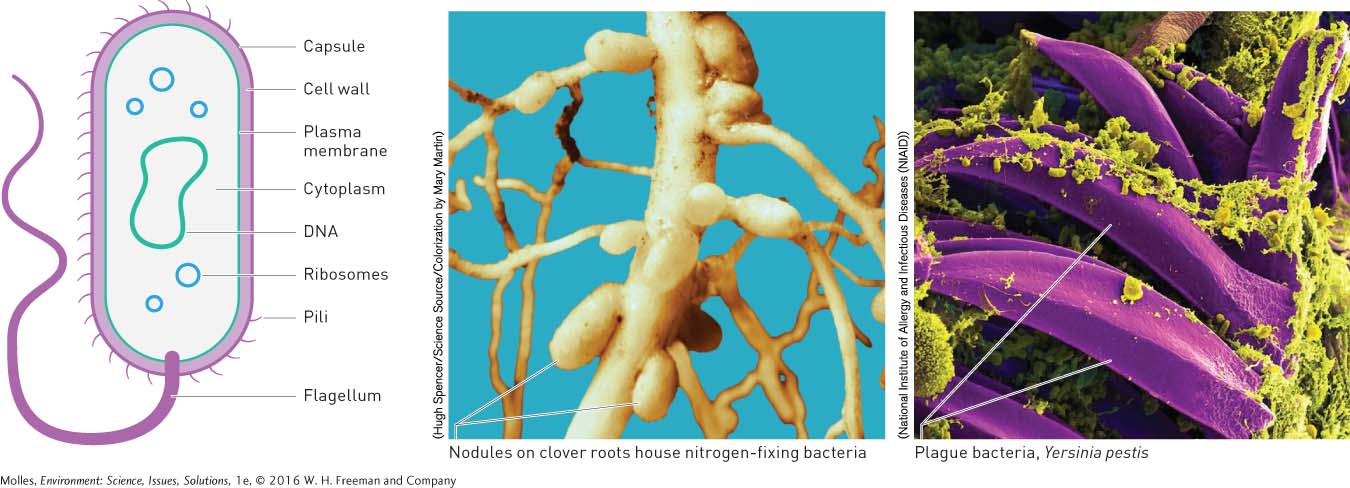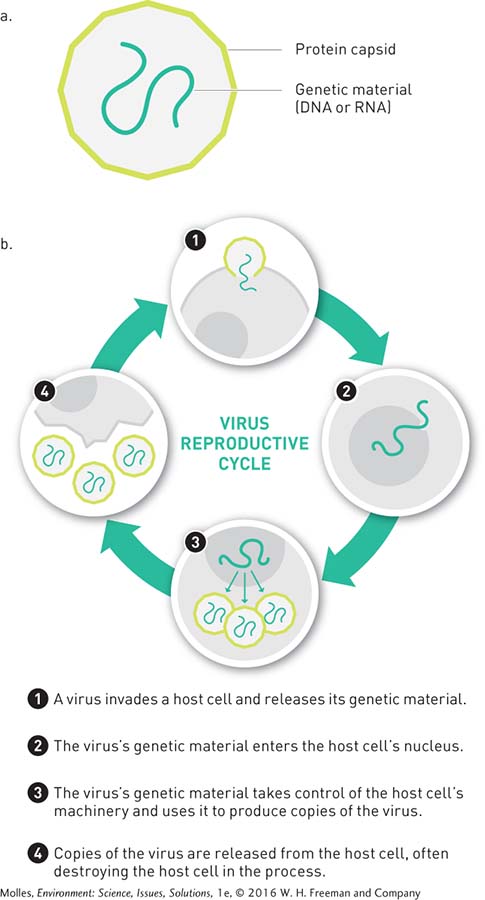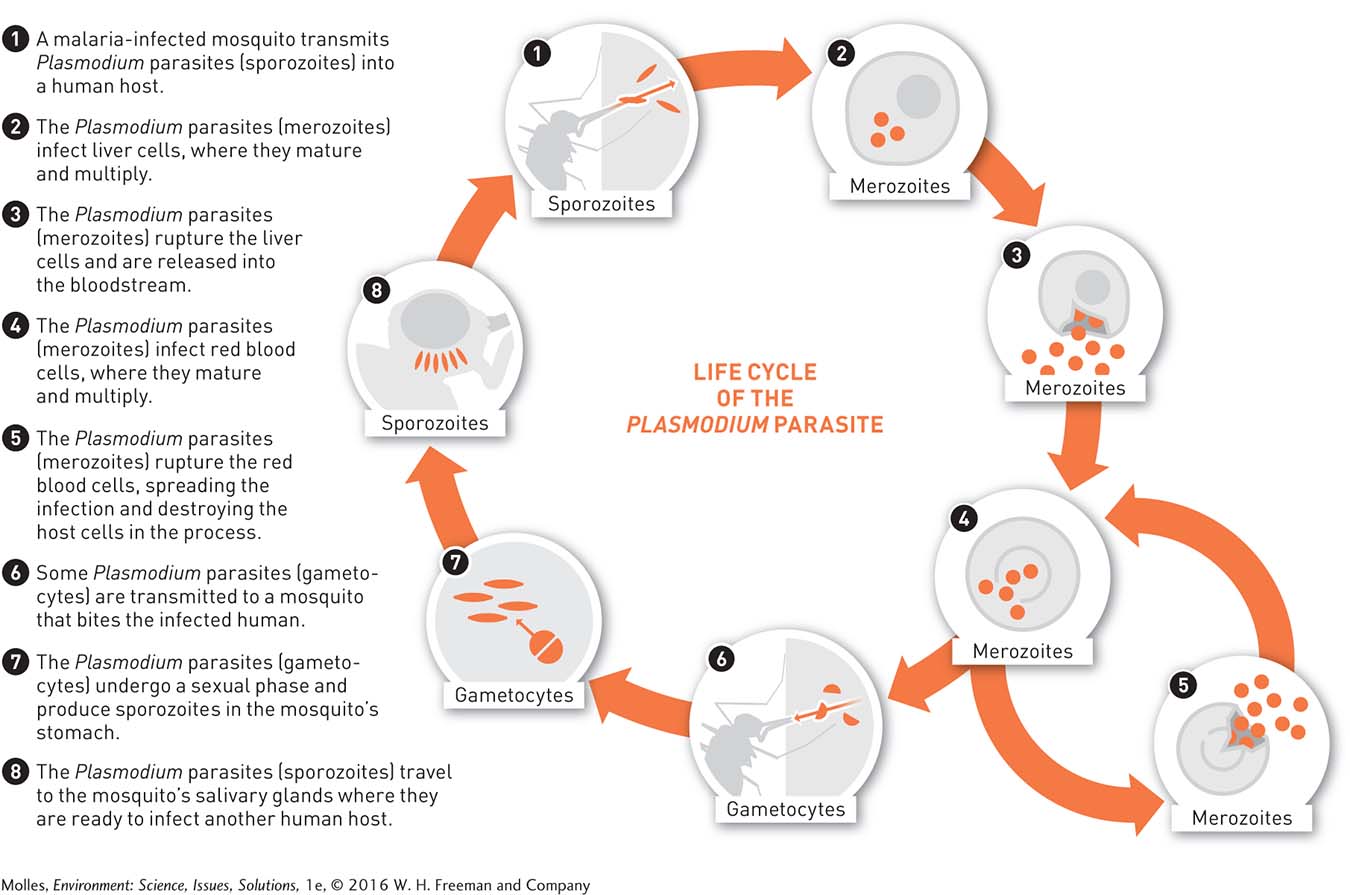11.2 Bacteria, viruses, and parasites are spread through the environment
pandemic Expansion of a disease affecting a large proportion of a population in a very large geographic area (e.g., across an entire continent).
The Black Death: The very name evokes horrifying images (Figure 11.5). This pandemic outbreak of bubonic plague, which peaked in Europe around 1350, killed an estimated one-

How many people would die if a pandemic killed a third of the current global population?

disease A condition in which normal biological function is impaired by bacteria, viruses, parasites, improper diet, or pollutants.
At the time, it was thought that the Black Death, and disease in general—
pathogen An organism that produces illness.
Bacteria are not the only pathogens (organisms that produce illness). Viruses and parasites also produce disease in humans and other organisms. Although we now understand how most diseases are transmitted, infectious disease has remained the leading cause of death due to environmental hazard over the last century. Let’s consider the three classes of pathogens—
Bacterial Disease
bacteria Single-
Bacteria (singular bacterium) existed billions of years before the first multicellular organisms developed. Most bacteria are single-

Bacteria live everywhere—

How does the discovery of the numbers and essential services provided by bacteria challenge the concept of human individuality?
It is the harmful bacteria that cause bacterial diseases, but they normally act with an environmental agent. An environmental agent can be as simple as a sharp object that penetrates the skin and allows bacteria to invade the tissues beneath; or it can be as complex as those associated with the cholera bacterium, which adjusts its lethality in response to the pollution of water sources by human waste.
The majority of disease-
Other bacterial diseases, such as tuberculosis, are the result not of toxins but of bacteria growing in the tissues of their host and competing with the host’s cells for nutrients.
Viral Diseases
virus A structurally simple disease-
Viruses are responsible for numerous health problems, ranging from relatively mild diseases, such as the common cold, to some of the most destructive diseases, including smallpox, rabies, Ebola, and AIDS (acquired immune deficiency syndrome), which is caused by HIV (human immunodeficiency virus).

Do you think viruses are living organisms? Why or why not?
Viruses, like bacteria, are pervasive in the environment. Although a virus is a microscopic pathogen like a bacterium, the two are quite different biologically. Viruses consist simply of genetic material encased in protein; they do not have the cell structures and biochemical pathways that allow bacteria to carry out all the processes necessary for life (Figure 11.7a). A virus can complete its own life cycle only by invading and taking over the cellular systems of animals, plants, or bacteria (Figure 11.7b). Viruses essentially highjack the machinery of a cell and use it to produce copies of the virus instead of carrying out the normal functions of the cell. When cells stop their normal processes, the symptoms of viral disease appear.

The damage that some viruses cause can be repaired. Viruses kill the cells they infect, but if healthy cells multiply, they replace the dead cells. Some cells, such as nerve cells, are not actively replaced, however, and the damage to the body can be permanent. Polio is an example of a viral disease that attacks nerve cells with crippling effects. HIV attacks cells of the human immune system, reducing the capacity of the body to resist infectious diseases. The Ebola virus, which is endemic to several African countries, also attacks the immune system. It causes fever and widespread inflammation, which damages the liver, intestine, and blood vessels and potentially leads to bleeding from the eyes and nose.
One of the most common types of viruses that affect humans is the influenza virus. Most of us have had the flu at one time or another and have suffered from its symptoms: fever, cough, congestion of the lungs, sore throat, headache, sore muscles, and fatigue. Though most people recover from the flu within a week or two, the disease still takes a substantial toll on populations, especially among the elderly and the chronically ill. In the United States each year, approximately 100,000 victims of seasonal flu are hospitalized and there are about 20,000 flu-
“It’s flu season, be sure to get your shot!”—it’s a familiar refrain each year. Annual vaccinations are necessary for protection because viral genetic material, in this case that of the influenza virus, can change. In other words, viruses evolve. One of the most changeable of the viruses is HIV, which makes combating AIDS much more difficult.
Parasitic Diseases
parasite An organism that lives in or on another organism, called the host; hosts are harmed by the parasite, while the parasite receives various benefits from the host (e.g., food, protection, dispersal of offspring).
Parasitism is another major source of disease in human populations. A parasite is an organism that lives in or on another organism, called the host (Figure 11.8). Parasitism is a particular type of ecological relationship similar to that between predators and prey (see Chapter 3, page 71), in which the host is harmed by the parasite and the parasite extracts benefits from the host, such as food, protection, dispersal of offspring, and so forth.

Parasitism is a very successful way of life. Because every species of animal, including all insects and other arthropods, is a host to at least one species of parasitic roundworm, and because most animal species serve as hosts for multiple species of roundworms, there are probably more species of roundworms than all other kinds of animals combined. However, they remain understudied, so we don’t know for sure.
Humans serve as hosts to at least several hundred species of parasites that live on us and in us. For instance, outbreaks of head lice plague schools every year, and infestations of bed bugs are becoming a problem for travelers, even those who stay in expensive hotels. Both lice and bed bugs are external parasites that suck blood, as are mosquitoes and other biting insects. A variety of worm-
Many parasites do not cause a disease, but a heavy infestation of blood-
Seven of the top 10 diseases targeted by the World Health Organization’s Special Programme for Research and Training in Tropical Diseases are parasitic diseases. Tropical parasitic diseases take a terrible toll on human populations, infecting hundreds of millions of people each year. They are responsible for more than a million deaths annually and, in some cases, are spreading rapidly. The range of some tropical diseases, such as dengue fever, is expanding as global climate change allows the mosquitoes that carry the disease to spread northward.
Transmission of Pathogens
Pathogens are found virtually everywhere in the environment. Bacteria and viruses travel in air, in water, and in the bodies of organisms. They can enter through open wounds, via the lungs, and via the intestine.
However, pathogens must enter a host’s body before they can cause an infection, and hosts are well protected. The dense populations of benign bacteria on the skin and in the nose, mouth, and intestine form the first line of defense against infection by pathogenic bacteria. By occupying every site in the body that is suitable for bacterial growth, these harmless bacteria make it difficult for invading pathogenic bacteria to find a place to live. But, by invading in overwhelming numbers, disease-
vector An organism that transmits a pathogen or parasite to other organisms (e.g., mosquitoes transmit malaria and other diseases to humans and other species).
Parasites are often transmitted indirectly, through secondary organisms called vectors. Some of the most significant vectors are biting insects such as mosquitoes and flies. The Plasmodium protozoan, which causes malaria, is carried by mosquitoes and is injected into its animal host when a biting mosquito releases saliva to prevent blood from clotting (Figure 11.9).

Schistosomiasis is a parasitic disease common in many parts of the world, especially in areas with poor sanitation. The organism that causes schistosomiasis reproduces in humans. Its eggs are excreted with human urine and feces; when the eggs enter a body of water, they hatch into free-
Think About It
Pathogenic organisms must damage their host to get the nutrients they require, but they die when their host dies. Thus, they must be able to infect a new host before they kill their current host. What relationship would you expect to find between the virulence of a bacterium (i.e., how sick it makes its host) and how it is spread to a new host?
What benefit do bacteria gain from releasing exotoxins that rupture the cells of their host?
Why would you want to be careful not to kill off a bacterium, which releases endotoxins, too rapidly?
11.1–11.2 Science: Summary
Thousands of chemicals are manufactured and released into the environment each year, but a minority have been tested to determine their impact on environmental health. Many of these chemicals persist and accumulate in the environment and have the potential to harm humans and other animals. Toxic substances cause harm through various processes: Neurotoxins damage the nervous system; carcinogens and mutagens damage genetic material; allergens cause mild to severe allergic reactions; teratogens harm embryos; and endocrine disruptors change or damage the hormonal system.
Bacteria exist everywhere on the planet. Most have no effect on humans at all; many bacteria are beneficial, but a few can cause illness or death. Viruses act by invading healthy cells and taking over the machinery of the host’s cell, turning it to the production of more viruses. Parasites live in or on other organisms. Many parasites have no measurable effect on the host, but some harm their host directly or carry pathogenic bacteria or viruses.